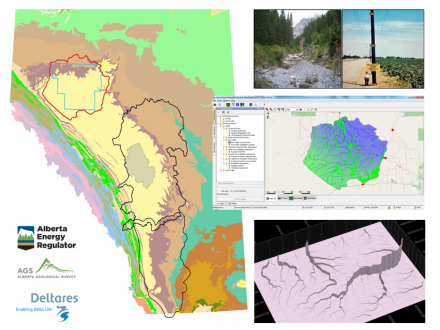
Because of its location atop a thick sedimentary basin with a world-class endowment of hydrocarbons and coal, Alberta’s long-term economic performance and rate of population growth is usually well above the Canadian average. Energy-development growth leads to ongoing increases in water demand for energy extraction and leads to risk of water-quality degradation due to waste-management practices, changes in land use, or spills.
Allocations and diversions of water in Alberta in all sectors including energy have traditionally been focused on surface-water sources. Groundwater diversions have historically represented a very minimal set of the total permitted water diversions. But Alberta’s surface-water supplies are reaching their limits. The largest river basin of southern Alberta is now closed to new surface-water allocations. Annual snowpack and summer glacial meltwaters are becoming more unreliable and both main stem and tributary rivers in central and northern Alberta are becoming stressed with respect to flows.
Alberta’s groundwater resources, on the other hand, are relatively undeveloped. The importance of groundwater to Alberta as an untapped resource capable of meeting future water demand for energy development while sustaining environmental quality means that investment in good groundwater management is vital for Alberta’s energy sector.
Predictive groundwater computer-simulations (groundwater models) are essential for groundwater-resource management. Groundwater models honour local geology and obey physical and chemical principles of hydrogeology as translated into mathematical and statistical formulations. The models can be solved or “run” in hindcast and forecast modes to assess pre-development natural resource states (essential understanding for ecological service values) as well as trajectories of groundwater quantity and quality change under past and future development.
There is a clear need for a groundwater information system based on trusted groundwater models to evaluate and assessof proposed new water wells and their cumulative (environmental) effects to support licensing processes and to monitor the impacts of operations on groundwater resources and groundwater quality. The groundwater information system should be an open platform and present impacts of proposed activities in a transparent way.
The main users of this groundwater information system are industry operators, especially in the energy sector, municipalities, farmers, land-owners, policy makers, land-use and natural resource planners, and regulators.
The main beneficiaries of the groundwater information system are Albertans at large, who want assurance that drinking water is safe, that there is secure water supply for the economy, and that Alberta’s aquatic ecosystems remain healthy.
Project Goal
Scope of this project is to design the Groundwater Chautauqua Information System, a conceptual multi-stakeholder information system on Alberta’s groundwater resources to evaluate and assess future groundwater demand while sustaining water resources and environmental quality.
The envisaged objectives are:
• To design a social and technology platform (Groundwater Chautauqua Information System) needed for developing, sharing, and continuously improving groundwater models in Alberta among specialists in Alberta government, consultants and service companies, the energy industry and other sectors.
• To develop features of the Groundwater Chautauqua Information System
• To identify further developments of the Groundwater Chautauqua Information System based on users’ feedback.
Albertans with a stake in well-regulated energy development will benefit from the existence of a living, public-domain, ready-for-use, calibrated, and trusted set of groundwater flow models in areas of intense energy development which meet international scientific standards. The models will be continuously re-used, updated, and improved by the professional user community to best meet Alberta’s goals of having safe drinking water, having secure groundwater supply for energy developments, and maintaining healthy groundwater-supported ecosystems. The results of the models will flow easily through the Groundwater Chautauqua Information System to the front-line regulatory workers in AER and AEP who administer and adjudicate the Alberta Water Act in ways that are fit for purpose and that make their work more effective and efficient on behalf of industry and all Albertans.
Activities
The project approach to achieve the objectives has been divided into 3 steps structured around a “lean-startup” style build-measure-learn cycle that couples accelerated development with low initial costs. The key to success in this approach was to build rapid prototypes (conceptual systems), called the minimum viable product (MVP), with the minimum amount of functionality that the target customer considers viable but no more than is needed to test your hypotheses with customers that the functionality solves the problem. Feedback from target customers was collected and measured and used to do another iteration of the MVP, during which time the existing solution was already being diffused through the entire base of target customers (from innovators to early adopters to early majority to late majority and finally to laggards). The goal of this approach was to leverage human creativity more effectively and to test the vision continuously and adapt immediately to customer needs that were exposed with increasing certainty during the process.
There are two distinct (with different levels of expertise) customers for this work:
1) the regulators and regulated parities who use the results of the models and
2) the hydrogeology specialists who use groundwater models to produce the results.
In reality these two groups overlap significantly and their needs may be met by a common solution. Rather than separate the two audiences at the beginning based on our presumption of their different needs, we have used the MVP approach and their customer feedback to guide solution development and meet the stated objectives. We have admittedly started with a bias towards a single shared solution that could meet both stated objectives based on similar challenges solved in other nations, though we have retained flexibility to allow us pivot to a different solution space if so guided by the reactions of the customer groups.
The three steps in this approach were:
1. Step 1: Review the statement of the problem and build the first iteration of the minimum viable product. This connects the problem space to the solution space.
2. Step 2: Deploy and test user response to one or more potential solutions at the MVP level. Inside AER this has been done in conjunction with our Continuous Improvement team.
3. Step 3: Gather learnings and identify additional requirements from the complete Alberta community of hydrogeological practice for further development of the Groundwater Chautauqua Information System.
Expected Results
Step 1: Build The First MVP
This step will start with a workshop in Edmonton with a selected group of stakeholders and Deltares. This workshop will be a crucial activity in this project, because it will set the direction, objectives and specifications for the short and long term.
- Areas of focus will be West-Central Alberta (Fox Creek), Sylvan Lake sub-basin in the Edmonton-Calgary Corridor, and the region covering AGS’ Southern Alberta Regional Groundwater Simulation (SARGs).
• MVP should incorporate the production/calculation and dissemination of aquifer-yields (i.e. Fox Creek Area Groundwater Yield-Limits), water balances, and effects of existing and forecasted groundwater and surface water extractions (quantitative understanding of cumulative effects of water withdrawals) relevant to Alberta Water Act authorizations as a starting point
• Participants to be determined and invitations to be circulated in the first week of September.
The workshop is aimed at brainstorm, discussion and producing a functional design, but will also leave enough time to elaborate on the outcomes of the discussions, to co-create mock-ups and to start building the MVP. Through this collaborative creating (co-create) process in making the mock-ups, the outcome of the workshop will be conceptual design of the MVP. In this way the transfer of technical knowledge on the system/model configuration will start. The workshop will seek to clearly identify the needs and requirements (data, information, and knowledge) related to issuing water licenses. Technical staff from the stakeholders will explore model and data accessibility within the MVP to better address stakeholder requirements.
The MVP will be a minimum build. Therefore, only existing models (numerical, analytical, and map-based products) will be used without any further model development or calibration. The development of the MVP will start during the workshop in Edmonton. After the workshop the MVP will be developed further.
Step 2: Deploy the MVP to Target Customers and Measure Responses
This phase is focused on testing and deploying the MVP (stand-alone) at AER, and receiving feedback on the usability and added value of the MVP. This will be done during a workshop in Edmonton.
The workshop is aimed at receiving user feedback about needed functionality by having them respond to the MVP and allow modifications to be done in real time. Ideally, such improvements and further developments are done in conjunction with the modeling experts of AER, front-line regulators and supporting staff involved in continuous improvement of business processes at AER. A key deliverable of this step will be a new version of MVP that can be deployed into the organization without any further investment that provides value to the regulatory process.
Step 3: Learn from the experiences and identify additional requirements
This phase is focused on collecting feedback from stakeholders and identify user requirements from wider hydrogeological community in Alberta. What did we learn from the workshops, the MVP and the feedback given by the various involved people? Are we satisfied with the chosen direction and solutions? What are positive aspects of the first version of the MVP? What are the negative aspects? What gaps are determined? What are the specific requirements from the wider user community and stakeholders. This will result in a work plan for further development in the next phase after this project.
Innovativeness
The problem for groundwater models is that to be effective, models need to be developed in a highly collaborative, transparent manner so as to benefit from the experience and knowledge of the entire hydrogeology community while avoiding duplicate or competing models. Models should be widely shareable and updatable so the user community can drive continuous improvement. Shared models can build public trust so policy or regulatory limits imposed by authorities using model results will be accepted, reducing regulatory costs and social disputes. To be effective, the results of groundwater models need to be available, current, and properly formatted so users of the results have low-cost, efficient pathways to find, extract, understand, and apply the results with confidence.
The current state of groundwater modelling in Alberta’s energy sector is not ideal. Groundwater models are rare and often single-use creations. When built, they are expensive single-purpose constructs, poorly archived if at all, never shared or published, and they hardly ever benefit from collaborative inputs or continuous improvement achieved by constant use, field-truthing, and adjustment. The benefits of groundwater models are thus seldom realized through better policy, regulation, investment, or dispute resolution. The loss is multiplied by the opportunities lost when groundwater resources become overused or contaminated as a result of uninformed management practices. As well, without continuous use and sharing, groundwater models in Alberta usually become technologically stale as single-purpose models do not benefit from ongoing improvements in modelling practice or scientific advances. Models seldom get deployed in advanced applications like land-use planning, resource optimization or to support integrated cumulative effects management as often found in other sophisticated economies.
This problem can be solved by creating a Groundwater Information System where groundwater models can be shared, deployed, reused and improved by specialists in a cycle of continuous improvement and delivery of trusted, fit-for-purpose results to regulatory decision makers and industry in the energy sector.
Valorisation
Making the first minimum viable product of the Groundwater Chautauqua Information System and testing it immediately.
This product will be applicable for West-Central Alberta (Fox Creek), Sylvan Lake sub-basin in the Edmonton-Calgary Corridor, and the region covering AGS’ Southern Alberta Regional Groundwater Simulation (SARGs).
The Groundwater Chautauqua Information System should incorporate the production/calculation and dissemination of aquifer-yields (i.e. Fox Creek Area Groundwater Yield-Limits), water balances, and effects of existing and forecasted groundwater and surface water extractions (quantitative understanding of cumulative effects of water withdrawals) relevant to Alberta Water Act authorizations as a starting point.

